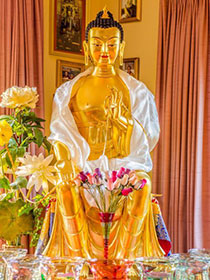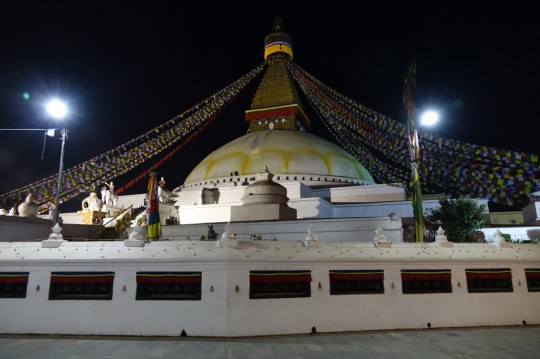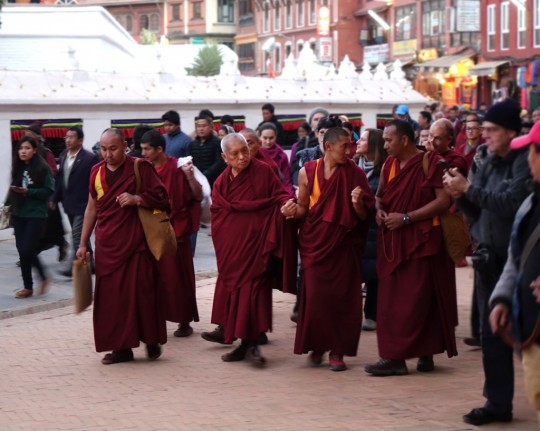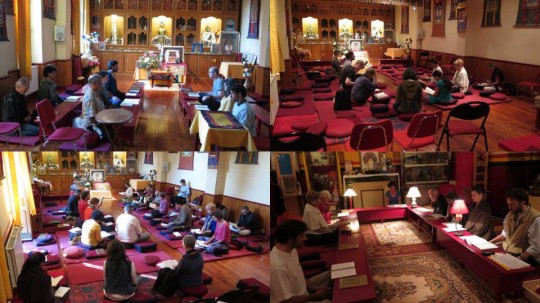- Home
- FPMT Homepage
Foundation for the Preservation of the Mahayana Tradition
The FPMT is an organization devoted to preserving and spreading Mahayana Buddhism worldwide by creating opportunities to listen, reflect, meditate, practice and actualize the unmistaken teachings of the Buddha and based on that experience spreading the Dharma to sentient beings. We provide integrated education through which people’s minds and hearts can be transformed into their highest potential for the benefit of others, inspired by an attitude of universal responsibility and service. We are committed to creating harmonious environments and helping all beings develop their full potential of infinite wisdom and compassion. Our organization is based on the Buddhist tradition of Lama Tsongkhapa of Tibet as taught to us by our founders Lama Thubten Yeshe and Lama Thubten Zopa Rinpoche.
- Willkommen
Die Stiftung zur Erhaltung der Mahayana Tradition (FPMT) ist eine Organisation, die sich weltweit für die Erhaltung und Verbreitung des Mahayana-Buddhismus einsetzt, indem sie Möglichkeiten schafft, den makellosen Lehren des Buddha zuzuhören, über sie zur reflektieren und zu meditieren und auf der Grundlage dieser Erfahrung das Dharma unter den Lebewesen zu verbreiten.
Wir bieten integrierte Schulungswege an, durch denen der Geist und das Herz der Menschen in ihr höchstes Potential verwandelt werden zum Wohl der anderen – inspiriert durch eine Haltung der universellen Verantwortung und dem Wunsch zu dienen. Wir haben uns verpflichtet, harmonische Umgebungen zu schaffen und allen Wesen zu helfen, ihr volles Potenzial unendlicher Weisheit und grenzenlosen Mitgefühls zu verwirklichen.
Unsere Organisation basiert auf der buddhistischen Tradition von Lama Tsongkhapa von Tibet, so wie sie uns von unseren Gründern Lama Thubten Yeshe und Lama Thubten Zopa Rinpoche gelehrt wird.
- Bienvenidos
La Fundación para la preservación de la tradición Mahayana (FPMT) es una organización que se dedica a preservar y difundir el budismo Mahayana en todo el mundo, creando oportunidades para escuchar, reflexionar, meditar, practicar y actualizar las enseñanzas inconfundibles de Buda y en base a esa experiencia difundir el Dharma a los seres.
Proporcionamos una educación integrada a través de la cual las mentes y los corazones de las personas se pueden transformar en su mayor potencial para el beneficio de los demás, inspirados por una actitud de responsabilidad y servicio universales. Estamos comprometidos a crear ambientes armoniosos y ayudar a todos los seres a desarrollar todo su potencial de infinita sabiduría y compasión.
Nuestra organización se basa en la tradición budista de Lama Tsongkhapa del Tíbet como nos lo enseñaron nuestros fundadores Lama Thubten Yeshe y Lama Zopa Rinpoche.
A continuación puede ver una lista de los centros y sus páginas web en su lengua preferida.
- Bienvenue
L’organisation de la FPMT a pour vocation la préservation et la diffusion du bouddhisme du mahayana dans le monde entier. Elle offre l’opportunité d’écouter, de réfléchir, de méditer, de pratiquer et de réaliser les enseignements excellents du Bouddha, pour ensuite transmettre le Dharma à tous les êtres. Nous proposons une formation intégrée grâce à laquelle le cœur et l’esprit de chacun peuvent accomplir leur potentiel le plus élevé pour le bien d’autrui, inspirés par le sens du service et une responsabilité universelle. Nous nous engageons à créer un environnement harmonieux et à aider tous les êtres à épanouir leur potentiel illimité de compassion et de sagesse. Notre organisation s’appuie sur la tradition guéloukpa de Lama Tsongkhapa du Tibet, telle qu’elle a été enseignée par nos fondateurs Lama Thoubtèn Yéshé et Lama Zopa Rinpoché.
Visitez le site de notre Editions Mahayana pour les traductions, conseils et nouvelles du Bureau international en français.
Voici une liste de centres et de leurs sites dans votre langue préférée
- Benvenuto
L’FPMT è un organizzazione il cui scopo è preservare e diffondere il Buddhismo Mahayana nel mondo, creando occasioni di ascolto, riflessione, meditazione e pratica dei perfetti insegnamenti del Buddha, al fine di attualizzare e diffondere il Dharma fra tutti gli esseri senzienti.
Offriamo un’educazione integrata, che può trasformare la mente e i cuori delle persone nel loro massimo potenziale, per il beneficio di tutti gli esseri, ispirati da un’attitudine di responsabilità universale e di servizio.
Il nostro obiettivo è quello di creare contesti armoniosi e aiutare tutti gli esseri a sviluppare in modo completo le proprie potenzialità di infinita saggezza e compassione.
La nostra organizzazione si basa sulla tradizione buddhista di Lama Tsongkhapa del Tibet, così come ci è stata insegnata dai nostri fondatori Lama Thubten Yeshe e Lama Zopa Rinpoche.
Di seguito potete trovare un elenco dei centri e dei loro siti nella lingua da voi prescelta.
- 欢迎 / 歡迎
简体中文
“护持大乘法脉基金会”( 英文简称:FPMT。全名:Foundation for the Preservation of the Mahayana Tradition) 是一个致力于护持和弘扬大乘佛法的国际佛教组织。我们提供听闻,思维,禅修,修行和实证佛陀无误教法的机会,以便让一切众生都能够享受佛法的指引和滋润。
我们全力创造和谐融洽的环境, 为人们提供解行并重的完整佛法教育,以便启发内在的环宇悲心及责任心,并开发内心所蕴藏的巨大潜能 — 无限的智慧与悲心 — 以便利益和服务一切有情。
FPMT的创办人是图腾耶喜喇嘛和喇嘛梭巴仁波切。我们所修习的是由两位上师所教导的,西藏喀巴大师的佛法传承。
繁體中文
護持大乘法脈基金會”( 英文簡稱:FPMT。全名:Found
ation for the Preservation of the Mahayana Tradition ) 是一個致力於護持和弘揚大乘佛法的國際佛教組織。我們提供聽聞, 思維,禪修,修行和實證佛陀無誤教法的機會,以便讓一切眾生都能 夠享受佛法的指引和滋潤。 我們全力創造和諧融洽的環境,
為人們提供解行並重的完整佛法教育,以便啟發內在的環宇悲心及責 任心,並開發內心所蘊藏的巨大潛能 — 無限的智慧與悲心 – – 以便利益和服務一切有情。 FPMT的創辦人是圖騰耶喜喇嘛和喇嘛梭巴仁波切。
我們所修習的是由兩位上師所教導的,西藏喀巴大師的佛法傳承。 察看道场信息:
- FPMT Homepage
- News/Media
-
- Study & Practice
-
-
- About FPMT Education Services
- Latest News
- Programs
- New to Buddhism?
- Buddhist Mind Science: Activating Your Potential
- Heart Advice for Death and Dying
- Discovering Buddhism
- Living in the Path
- Exploring Buddhism
- FPMT Basic Program
- FPMT Masters Program
- FPMT In-Depth Meditation Training
- Maitripa College
- Lotsawa Rinchen Zangpo Translator Program
- Universal Education for Compassion & Wisdom
- Online Learning Center
-
- Prayers & Practice Materials
- Overview of Prayers & Practices
- Full Catalogue of Prayers & Practice Materials
- Explore Popular Topics
- Benefiting Animals
- Chenrezig Resources
- Death & Dying Resources
- Lama Chopa (Guru Puja)
- Lama Zopa Rinpoche: Compendium of Precious Instructions
- Lama Zopa Rinpoche: Life Practice Advice
- Lama Zopa Rinpoche Practice Series
- Lamrim Resources
- Mantras
- Prayer Book Updates
- Purification Practices
- Sutras
- Thought Transformation (Lojong)
- Audio Materials
- Dharma Dates - Tibetan Calendar
- Translation Services
- Publishing Services
- Ways to Offer Support
- Prayers & Practice Materials
-
- Teachings and Advice
- Find Teachings and Advice
- Lama Zopa Rinpoche Advice Page
- Lama Zopa Rinpoche: Compendium of Precious Instructions
- Lama Zopa Rinpoche Video Teachings
- ༧སྐྱབས་རྗེ་བཟོད་པ་རིན་པོ་ཆེ་མཆོག་ནས་སྩལ་བའི་བཀའ་སློབ་བརྙན་འཕྲིན།
- Podcasts
- Lama Yeshe Wisdom Archive
- Buddhism FAQ
- Dharma for Young People
- Resources on Holy Objects
- Teachings and Advice
-
-
*If a menu item has a submenu clicking once will expand the menu clicking twice will open the page.
-
-
- Centers
-
- Teachers
-
- Projects
-
-
-
-
*If a menu item has a submenu clicking once will expand the menu clicking twice will open the page.
-
-
- FPMT
-
-
-
-
-
The sun of real happiness shines in your life when you start to cherish others.
Lama Zopa Rinpoche
-
-
-
- Shop
-
-
-
The Foundation Store is FPMT’s online shop and features a vast selection of Buddhist study and practice materials written or recommended by our lineage gurus. These items include homestudy programs, prayers and practices in PDF or eBook format, materials for children, and other resources to support practitioners.
Items displayed in the shop are made available for Dharma practice and educational purposes, and never for the purpose of profiting from their sale. Please read FPMT Foundation Store Policy Regarding Dharma Items for more information.
-
-
Lama Zopa Rinpoche News and Advice
17
‘This Is Buddha Nature’
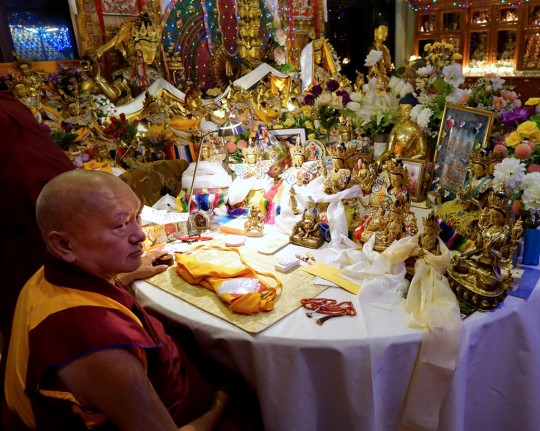
Lama Zopa Rinpoche at night in front of his work table at Kopan Monastery, which has so many statues … another altar! Nepal, December 2014. Photo by Ven. Roger Kunsang.
Lama Zopa Rinpoche taught in December as part of the Kopan Monastery November course. On December 7, Ven. Roger Kunsang shared on his Twitter page:
Lama Zopa: The mind is empty of a real mind. This is because the mind exists in mere name, merely labeled by the mind. This is buddha nature.
Ven. Roger Kunsang, Lama Zopa Rinpoche’s assistant and CEO of FPMT Inc., shares Lama Zopa Rinpoche’s recent pith sayings on Ven. Roger’s Twitter page. (You can also read them on Ven. Roger’s Facebook page.)
More information, photos and updates about FPMT spiritual director Lama Zopa Rinpoche can be found on Rinpoche’s homepage. If you’d like to receive news of Lama Zopa Rinpoche via email, sign up to Lama Zopa Rinpoche News.
- Tagged: kopan course, kopan monastery, twitter
- 0
16
Remembering Death
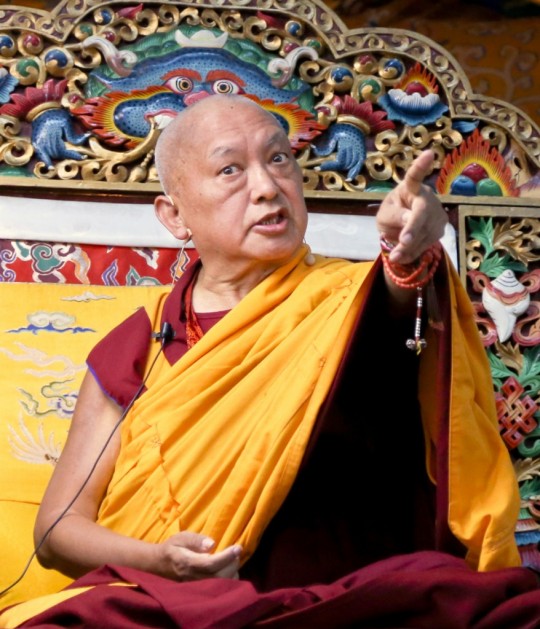
Lama Zopa Rinpoche teaching at Kopan Monastery, Nepal, December 2014. Photo by Ven. Thubten Kunsang.
During a teaching at the recent November Course at Kopan Monastery, Lama Zopa Rinpoche said, “This life is so, so, so precious. Your death is definite; it can come at any moment.”
Rinpoche has taught many times on the importance of remembering death. Here’s an excerpt from a teaching given at Nalanda Monastery in France in 1995 and published in Mandala May-June 1997:
“Reflecting on impermanence and death in itself is not really a big deal, but thinking about it because of what follows after the death is important. If there is negative karma, then there are the lower realms of unimaginable sufferings, and this is something that can be stopped immediately.
“We cannot be liberated from samsara within this hour, today, this week or even this year, but we can purify negative karma now, this hour today, and therefore stop being reborn in the lower realms if we die now, this hour, today. This is possible.
“By remembering impermanence and death, karma and the lower realms of suffering, the mind is persuaded to use the solution of Dharma practice. Immediately the mind prepares for death. Immediately it purifies the heavy negative karmas that cause one to remain in the lower realms, where there are unimaginable sufferings and no possibility to practice Dharma.
“Whenever there are problems in our lives it is always good to remember the lower realms of suffering. We can’t stand the problems we have now, but the lower realms of suffering are a zillion, zillion, zillion times greater, like the sky. If we put together all the energy of fire, no matter how hot, it is cool compared to one tiny fire spark of hell. All the energy of this human world’s fire put together is cool compared to one tiny fire spark of the hell realm. Like this, it’s always good to make a comparison. …”
Read the entire teaching “Remembering Death” from Mandala May-June 1997.
Lama Zopa Rinpoche is the spiritual director of the Foundation for the Preservation of Mahayana Tradition (FPMT), a Tibetan Buddhist organization dedicated to the transmission of the Mahayana Buddhist tradition and values worldwide through teaching, meditation and community service.
- Tagged: death, lama zopa rinpoche
- 0
15
Lama Zopa Rinpoche and the Kopan November Course
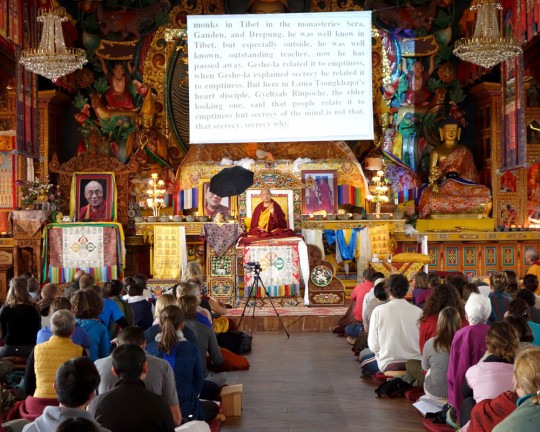
Lama Zopa Rinpoche teaching at the November course at Kopan Monastery, Nepal, December 2014. Photo by Ven. Roger Kunsang.
In late November 2014, Lama Zopa Rinpoche arrived at Kopan Monastery in Nepal and like most other years, he gave teachings to students attending the month-long lam-rim course, known as the November Course. [Kopan offers several different course and retreats for lay students and non-Tibetan monastics year round.] The November courses have been taking place at Kopan for more than 40 years. Many of FPMT’s senior students first met Lama Yeshe and Lama Zopa Rinpoche after walking up the Kopan hill for the month-long retreat.
The Lama Yeshe Wisdom Archive has collected and transcribed Lama Zopa Rinpoche’s teachings at these courses and they are available to anyone interested in learning about lam-rim.
Here’s a short excerpt of Rinpoche teaching during the 1979 Kopan Course, Lecture 35:
As the great bodhisattva Shantideva said in the teachings of the Bodhicaryavatara, “If one did not give harm to others, nobody would give harm to oneself. In previous times, I caused harm, I harmed beings like me. Therefore, it is worthwhile for me to receive the harm given by other sentient beings.”
What the great bodhisattva Shantideva is saying is that if one hasn’t accumulated negative karma of giving harm to others in the first place, no other sentient being would give harm in this life to oneself. There’s no cause that obliges them to give harm to oneself, there’s no cause. The reason I receive harm is because I harmed others in the past. That karma has obliged them to harm me. I have created a cause – giving harm to others – so the result is receiving harm myself. Therefore, Shantideva is saying, it is worthwhile for me to receive harm from other sentient beings. Shantideva explained this logically, the whole evolution, why we receive harm from other sentient beings. As he explained, instead of rejecting the harm that other beings give us, accept it. It’s worthwhile to receive it. Think, “It is good; he’s harming me but that is very good, because I harmed him similarly like this in the past. I should have it, I should receive it.”
More information, photos and updates about FPMT spiritual director Lama Zopa Rinpoche can be found on Rinpoche’s webpage. If you’d like to receive news of Lama Zopa Rinpoche via email, sign up to Lama Zopa Rinpoche News.
- Tagged: kopan course, lama zopa rinpoche
- 0
12
Lama Zopa Rinpoche on Karma

Lama Zopa Rinpoche teaching during the November course at Kopan Monastery, December 2014. Photo by Ven. Thubten Kunsang.
Lama Zopa Rinpoche made the point while teaching a the Kopan Monastery November course, “We can spend hours in meditation, but we don’t take care of karma! That is not correct meditation.”
Rinpoche offered these observations on karma in 2000, which you can find on the Lama Yeshe Wisdom Archive:
“In some ways, you can say even just looking at flowers is an expression of your mind. In your view, you see so many different plants, leaves, and flowers of incredible designs and shapes, each having its own beauty. Anything that is beautiful, that you enjoy, that you find nice, comes from your good karma; it is a production of good karma, an expression of your mind, your positive thoughts. It is like the reflection of your face in a mirror. If your face has many pimples or cuts, or your nose is missing, that’s what you see in the mirror. A clean, beautiful face reflects a clean, beautiful image. Another example is taking a picture: you put the imprint of people or a country on the negative roll of film using the camera, then after the roll is developed, the image appears from the paper as photos, a movie, a TV image, or a slide show. In our lives, everything that appears to us – an enemy or a friend – is like that.
“Ugly, beautiful, indifferent, everything that appears is exactly like that – coming from our mind, a creation of our mind. We should understand, like looking at the flowers, that how a person thinks about you, talks to you, or behaves towards you, pleasantly or unpleasantly, liking you or not liking you, having pleasant or unpleasant feelings towards you – all comes from your mind and is a production or reflection of your negative or positive thoughts. They are productions or creations of karma.”
From the page, “Understanding Karma” in “Lama Zopa Rinpoche’s Online Advice Book”
Learn more about FPMT spiritual director Lama Zopa Rinpoche and his beneficial activities by visiting Rinpoche’s webpage, where you will find links to Rinpoche’s schedule, new advice, recent video, photos and more.
- Tagged: karma, kopan course 2014, lama zopa rinpoche
- 0
11
Rinpoche at Boudhanath, Part 2

Lama Zopa Rinpoche offering a Dharmachakra at Boudhanath, Nepal, December 2014. Photo by Ven. Roger Kunsang.
“After 8 p.m., most people have finished circumambulating the stupa at Boudha,” Ven. Roger Kunsang shared. ”This is when Rinpoche often starts.”
After circumambulating the Boudha Stupa seven times earlier this week, Lama Zopa Rinpoche offered three Dharmachakras to the stupa in three different directions late at night, with many prayers to benefit sentient beings.
In 2013, Rinpoche wrote a letter to a student who had done 1,000 circumambulations of the stupa at Boudha:
Thank you very, very much for your kind letter. A billion, zillion, trillion, numberless thanks from my heart and bones that you circumambulated Boudha Stupa 1,000 times. This is unbelievable, unbelievable. I wish I could do that. Dagri Rinpoche tries to circumambulate when he goes to Nepal, even to the extent of getting wounds on his feet, until blood comes.
The monk who is the leader of pujas at Kopan Monastery, his mother lives at Boudha and circumambulates the stupa 100 times each day. Of course she is reciting mantras and going around the stupa with a mind having renounced this life, so that is the purest Dharma. Then you die with no problems; you die with the greatest happiness in the life.
For more on practices relating to stupas, visit FPMT Education Services’ stupa resource page. Additional advice from Rinpoche on stupas can be found on the Lama Yeshe Wisdom Archive.
Learn more about Lama Zopa Rinpoche, spiritual director of the Foundation for the Preservation of Mahayana Tradition (FPMT), and Rinpoche’s vision for a better world. Sign up to receive news and updates.
- Tagged: boudhanath stupa, lama zopa rinpoche
- 0
10
Rinpoche at Boudhanath, Part 1
Lama Zopa Rinpoche regularly circumambulates Boudha Stupa while he is in residence at Kopan Monastery. Rinpoche arrived at Kopan in late November to participate in the annual November course. Ven. Roger Kunsang shared about this photo, “Rinpoche did seven korwa into the evening and then offered three Dharmachakras to the stupa in three different directions.”
Ven. Sarah Thresher told a story in Mandala July-September 2009 about how Lama Atisha and the Kadampa geshes used to circumambulate stupas. She wrote:
Dromtönpa once asked Lama Atisha,”Why don’t you relax? Why not practice virtue sitting? Why do this common practice of circumambulation?” Lama Atisha replied, “You don’t understand. When I circumambulate I accumulate all three virtuous actions of body, speech and mind. When I sit there’s only one. In terms of merit, there is no greater practice than circumambulation!”
FPMT Education Services has created a PDF booklet of Rinpoche’s advice on circumambulation, including mantras to recite, that is available as a free PDF download through the FPMT Foundation Store.
Lama Zopa Rinpoche is the spiritual director of the Foundation for the Preservation of Mahayana Tradition (FPMT), a Tibetan Buddhist organization dedicated to the transmission of the Mahayana Buddhist tradition and values worldwide through teaching, meditation and community service.
- Tagged: boudhanath stupa, circumambulation, lama zopa rinpoche
- 0
9
Lama Zopa Rinpoche’s Birthday Celebrated
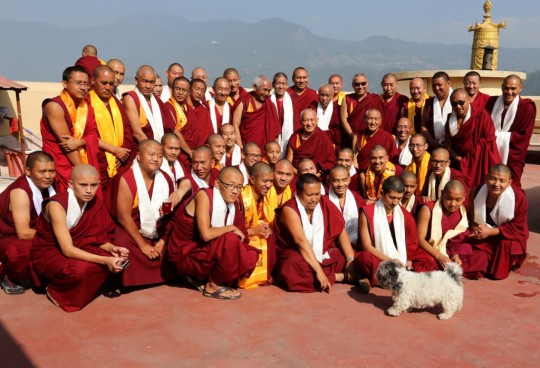
Lama Zopa Rinpoche with some of the senior Kopan monks, Kopan Monastery, Nepal, December 2, 2014. Photo by Ven. Roger Kunsang.
Lama Zopa Rinpoche had his first birthday celebration at 69 years old at Kopan Monastery in December. ”Kopan monks wanted to create merit so they decided to celebrate Rinpoche’s birthday,” shared Ven. Roger Kunsang. ”[In the photo] here many of the older monks are with Rinpoche and also Kopan Abbot Geshe Chonyi. Rinpoche from his own side thought it was unnecessary to celebrate.”
More information, photos and updates about FPMT spiritual director Lama Zopa Rinpoche can be found on Rinpoche’s webpage. If you’d like to receive news of Lama Zopa Rinpoche via email, sign up to Lama Zopa Rinpoche News.
- Tagged: birthday, lama zopa rinpoche
- 0
8
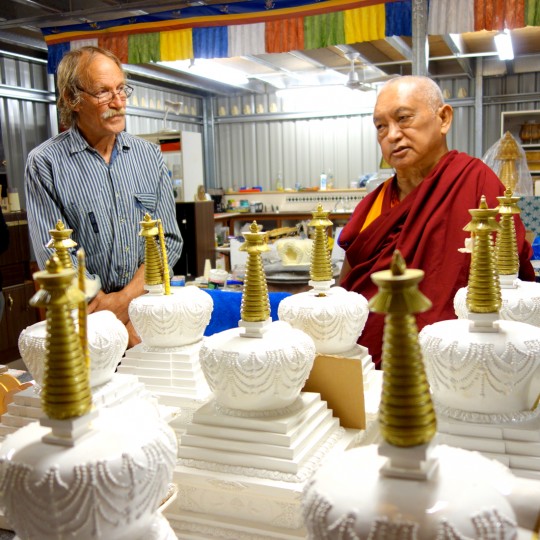
Lama Zopa Rinpche with Garrey Foulkes in the recently completed art studio at Chenrezig Institute, Eudlo, Queensland, Australia, September 2014. Photo by Ven. Roger Kunsang.
“… Every time you look at holy objects – pictures of the Buddha, statues, scriptures, stupas – they plant the seed of liberation and enlightenment in your mental continuum. So every time you look at them they purify your mind. They plant the seed of enlightenment, which includes all the causes to achieve enlightenment,” Lama Zopa Rinpoche instructs in “Why Holy Objects Are Precious and Wish-fulfilling.”
“How? When you look at them they plant a seed or positive imprint on your mental continuum so that later when you meet Buddhadharma, either in this life or in future lives, you are able to understand the words and the meaning of the teachings. From that, you are able to practice the meaning of the Dharma you have understood, which causes you to cease the gross and subtle defilements by actualizing the path and then your mental continuum becomes omniscient mind. This is what is meant when we say that by seeing holy objects it plants the seed of enlightenment on the mind – it contains the whole path from guru devotion and the three principals up to the two stages of tantra and enlightenment. Seeing holy objects makes us actualize all of this as a result. This is the effect we get from seeing them and this is how they cause us to achieve enlightenment. …”
You can read the complete advice “Why Holy Objects Are Precious and Wish-fulfilling” as a PDF found with other advice from Rinpoche on holy objects on FPMT.org.
Learn more about Lama Zopa Rinpoche, spiritual director of the Foundation for the Preservation of Mahayana Tradition (FPMT), and Rinpoche’s vision for a better world. Sign up to receive news and updates.
- Tagged: advice, holy objects, lama zopa rinpoche
- 0
5
‘Each Living Being Is So Precious’
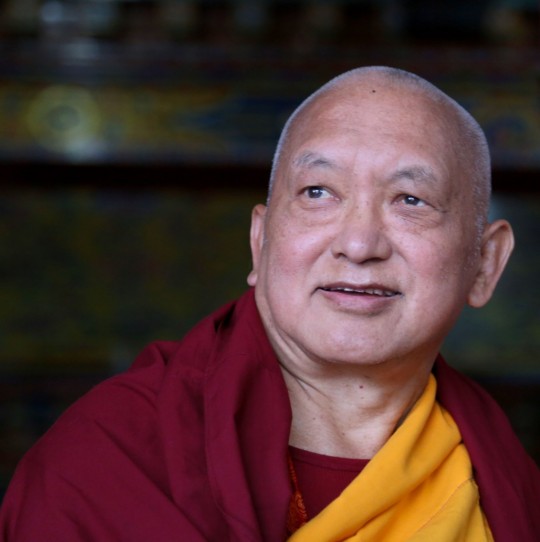
Lama Zopa Rinpoche teaching at the annual November course at Kopan Monastery, Nepal, December 2014. Photo by Ven. Thubten Kunsang.
“Lama Zopa Rinpoche: Each living being is so precious. If you really see living beings as precious, there will be no wars or problems! What pleases the buddhas most is benefiting others!”
Rinpoche has been teaching at the annual November course at Kopan Monastery in Nepal. Ven. Roger Kunsang, CEO of FPMT and Rinpoche’s attendant, has been jotting down quotes to share with students everywhere.
More information, photos and updates about FPMT spiritual director Lama Zopa Rinpoche can be found on Rinpoche’s homepage. If you’d like to receive news of Lama Zopa Rinpoche via email, sign up to Lama Zopa Rinpoche News.
- Tagged: kopan course, kopan course 2014, lama zopa rinpoche
- 0
5
The students of Institut Vajra Yogini, France, have committed to engage in yet another one of Lama Zopa Rinpoche’s Vast Visions for FPMT. This is the third Vast Vision they are actively supporting. In addition to hosting yearly Nyung-Nä retreats and building a large studio so that large thangkas can be painted, they will now recite the Sutra of Golden Light every day as a group with each participants’ recitation counted toward the accumulation of recitations. They organize two sessions daily to complete the entire sutra: 12pm-1pm and also 6pm-7pm. Students are also encouraged to recite from a distance. In the first nine days of beginning this new commitment, 35 full recitations of the sutra were accumulated and about 80 different students have taken part.
Institut Vajra Yogini decided to take on this commitment once they heard Lama Zopa Rinpoche advise about the benefits of the Sutra of Golden Light.
The holy Golden Light Sutra is the king of the sutras. It is extremely powerful and fulfills all one’s wishes, as well as bringing peace and happiness for all sentient beings, up to enlightenment. It is also extremely powerful for world peace, for your own protection and for the protection of the country and the world. Also, it has great healing power for people in the country.
—Lama Zopa Rinpoche
Please rejoice in these recitations. Anyone can join in this accumulation of merit and support of Lama Zopa Rinpoche’s Vast Visions by reciting this incredible sutra which you can download freely in several languages.
After five weeks of recitations, Institut Vajra Yogini’s students have accumulated 160 full recitations of the Sutra. Almost 200 people have taken part in these recitations! Please rejoice!
FPMT Education Services has created a resource page to help you learn more about and start reciting the Sutra of Golden Light. You can download the sutra in 12 languages, report completed recitations, share your experiences, and ask questions about the text itself.
- Tagged: golden light sutra, sutra of golden light, vast visions
- 0
4
‘Taking Care of Your Life’
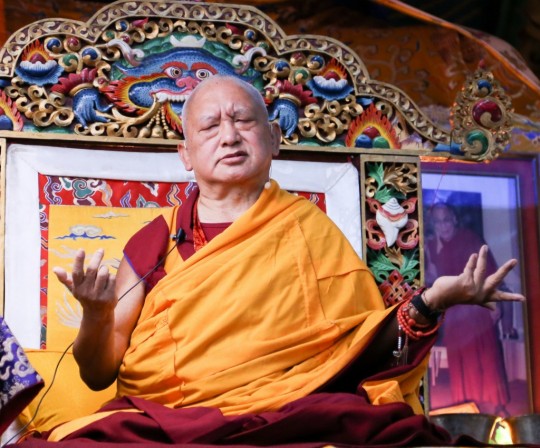
Lama Zopa Rinpoche teaching at the annual November course at Kopan Monastery, Nepal, December 2014. Photo by Ven. Thubten Kunsang.
“Lama Zopa Rinpoche: Taking care of your life is a huge question! Often we use [it] for attachment, for hurting others, for anger. We need to take care of our life with non-anger, non-greed, with non-attachment … with mindfulness on emptiness.”
Rinpoche has been teaching at the annual November course at Kopan Monastery in Nepal. Ven. Roger Kunsang, CEO of FPMT and Rinpoche’s attendant, has been jotting down quotes to share with students everywhere.
More information, photos and updates about FPMT spiritual director Lama Zopa Rinpoche can be found on Rinpoche’s homepage. If you’d like to receive news of Lama Zopa Rinpoche via email, sign up to Lama Zopa Rinpoche News.
- Tagged: kopan course, kopan course 2014, lama zopa rinpoche
- 0
3
Creating Happiness
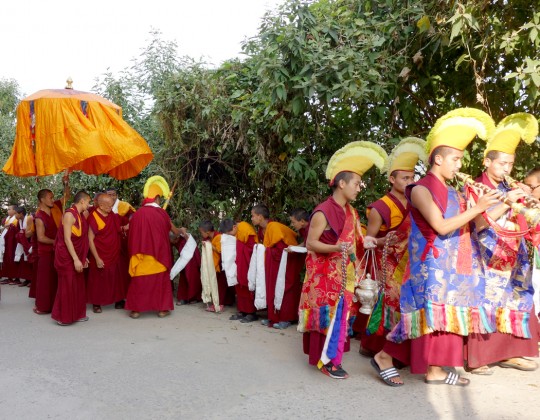
Lama Zopa Rinpoche arriving at Kopan Monastery, Nepal, November 2014. Photo by Ven. Roger Kunsang.
Lama Zopa Rinpoche recently arrived at Kopan Monastery for the November course. On December 2, Ven. Roger Kunsang shared on his Twitter page:
Lama Zopa: your coming to Kopan is to learn how to create the different levels of happiness. Normal education never teaches this.
Ven. Roger Kunsang, Lama Zopa Rinpoche’s assistant and CEO of FPMT Inc., shares Lama Zopa Rinpoche’s recent pith sayings on Ven. Roger’s Twitter page. (You can also read them on Ven. Roger’s Facebook page.)
More information, photos and updates about FPMT spiritual director Lama Zopa Rinpoche can be found on Rinpoche’s homepage. If you’d like to receive news of Lama Zopa Rinpoche via email, sign up to Lama Zopa Rinpoche News.
- Tagged: kopan monastery, lama zopa rinpoche, twitter
- 0
- Home
- News/Media
- Study & Practice
- About FPMT Education Services
- Latest News
- Programs
- New to Buddhism?
- Buddhist Mind Science: Activating Your Potential
- Heart Advice for Death and Dying
- Discovering Buddhism
- Living in the Path
- Exploring Buddhism
- FPMT Basic Program
- FPMT Masters Program
- FPMT In-Depth Meditation Training
- Maitripa College
- Lotsawa Rinchen Zangpo Translator Program
- Universal Education for Compassion & Wisdom
- Online Learning Center
- Prayers & Practice Materials
- Overview of Prayers & Practices
- Full Catalogue of Prayers & Practice Materials
- Explore Popular Topics
- Benefiting Animals
- Chenrezig Resources
- Death & Dying Resources
- Lama Chopa (Guru Puja)
- Lama Zopa Rinpoche: Compendium of Precious Instructions
- Lama Zopa Rinpoche: Life Practice Advice
- Lama Zopa Rinpoche Practice Series
- Lamrim Resources
- Mantras
- Prayer Book Updates
- Purification Practices
- Sutras
- Thought Transformation (Lojong)
- Audio Materials
- Dharma Dates – Tibetan Calendar
- Translation Services
- Publishing Services
- Teachings and Advice
- Find Teachings and Advice
- Lama Zopa Rinpoche Advice Page
- Lama Zopa Rinpoche: Compendium of Precious Instructions
- Lama Zopa Rinpoche Video Teachings
- ༧སྐྱབས་རྗེ་བཟོད་པ་རིན་པོ་ཆེ་མཆོག་ནས་སྩལ་བའི་བཀའ་སློབ་བརྙན་འཕྲིན།
- Podcasts
- Lama Yeshe Wisdom Archive
- Buddhism FAQ
- Dharma for Young People
- Resources on Holy Objects
- Ways to Offer Support
- Centers
- Affiliates Area
- Teachers
- Projects
- Charitable Projects
- Make a Donation
- Applying for Grants
- News about Projects
- Other Projects within FPMT
- Support International Office
- Projects Photo Galleries
- Give Where Most Needed
- FPMT
- Shop
Translate*
*powered by Google TranslateTranslation of pages on fpmt.org is performed by Google Translate, a third party service which FPMT has no control over. The service provides automated computer translations that are only an approximation of the websites' original content. The translations should not be considered exact and only used as a rough guide.Realize that the nature of your mind is different from that of the flesh and bone of your physical body. Your mind is like a mirror, reflecting everything without discrimination. If you have understanding-wisdom, you can control the kind of reflection that you allow into the mirror of your mind.







